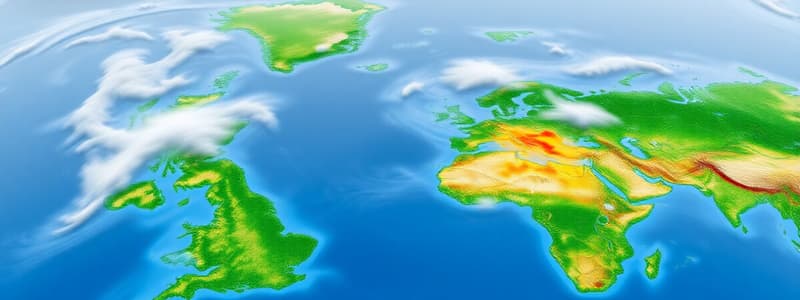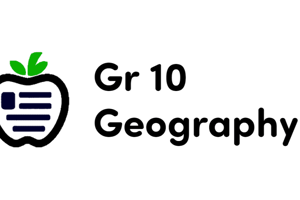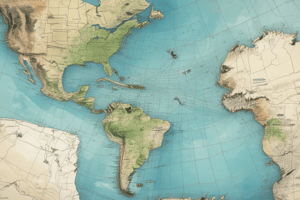Podcast
Questions and Answers
Why are weather maps and symbols essential tools for meteorologists?
Why are weather maps and symbols essential tools for meteorologists?
- They replace the need for radar and satellite data in weather forecasting.
- They simplify complex weather phenomena into abstract mathematical equations.
- They ensure that all weather predictions are 100% accurate.
- They provide a visually condensed way to interpret extensive atmospheric information. (correct)
What is the primary purpose of a station model in weather analysis?
What is the primary purpose of a station model in weather analysis?
- To provide a detailed historical account of past weather events.
- To display a wide range of weather data for a specific location and time. (correct)
- To predict long-term climate changes over decades.
- To measure the amount of solar radiation reaching the Earth's surface.
In a station model, where would you typically find the current temperature reading?
In a station model, where would you typically find the current temperature reading?
- Top left of the station model. (correct)
- Bottom center of the station model.
- Top right of the station model.
- Directly in the center of the station model.
What does the central symbol in a station model typically represent?
What does the central symbol in a station model typically represent?
If a station model includes a shaded circle, what aspect of the weather is it used to designate?
If a station model includes a shaded circle, what aspect of the weather is it used to designate?
What distinguishes a meteorologist from other types of scientists?
What distinguishes a meteorologist from other types of scientists?
What is the name of the process of weather prediction that involves the analysis of radar and satellite data?
What is the name of the process of weather prediction that involves the analysis of radar and satellite data?
In the context of cloud cover symbols within a station model, how is cloud coverage typically quantified?
In the context of cloud cover symbols within a station model, how is cloud coverage typically quantified?
A fully shaded circle is observed on a weather map. What weather condition does this symbol most likely represent?
A fully shaded circle is observed on a weather map. What weather condition does this symbol most likely represent?
A wind barb on a weather map is depicted with a single line and is pointing towards the southeast. Which of the following interpretations is most accurate?
A wind barb on a weather map is depicted with a single line and is pointing towards the southeast. Which of the following interpretations is most accurate?
Isobars are depicted closely together on a weather map. What atmospheric condition does this spacing signify?
Isobars are depicted closely together on a weather map. What atmospheric condition does this spacing signify?
A weather map shows a blue line with triangles. What type of weather front does this symbol represent and what are its typical effects?
A weather map shows a blue line with triangles. What type of weather front does this symbol represent and what are its typical effects?
Which of the following statements best describes the movement and typical weather conditions associated with a high-pressure system?
Which of the following statements best describes the movement and typical weather conditions associated with a high-pressure system?
On a weather map, an asterisk symbol (*) is used. Which weather phenomenon does this symbol typically represent?
On a weather map, an asterisk symbol (*) is used. Which weather phenomenon does this symbol typically represent?
A red line with half-circles is displayed on a weather map. What type of front does this symbol indicate and what weather changes are typically associated with it?
A red line with half-circles is displayed on a weather map. What type of front does this symbol indicate and what weather changes are typically associated with it?
Flashcards
Weather Map
Weather Map
A map displaying weather information in a condensed format.
Meteorologists
Meteorologists
Scientists who study Earth's atmosphere and weather to make predictions.
Forecasting
Forecasting
Predicting weather conditions by analyzing data.
Station Model
Station Model
Signup and view all the flashcards
Station Model Information
Station Model Information
Signup and view all the flashcards
Temperature on Station Model
Temperature on Station Model
Signup and view all the flashcards
Central Station Model Symbol
Central Station Model Symbol
Signup and view all the flashcards
Cloud Cover Symbols
Cloud Cover Symbols
Signup and view all the flashcards
Wind Barb
Wind Barb
Signup and view all the flashcards
Isobar
Isobar
Signup and view all the flashcards
High-Pressure System
High-Pressure System
Signup and view all the flashcards
Low-Pressure System
Low-Pressure System
Signup and view all the flashcards
Cold Front
Cold Front
Signup and view all the flashcards
Warm Front
Warm Front
Signup and view all the flashcards
Study Notes
- Weather maps condense large amounts of information in a readable format.
- Meteorologists use weather maps to forecast and display weather conditions.
- Weather maps use specific symbols to represent weather events and their characteristics.
Analyzing Weather with Weather Symbols
- Meteorology is the study of Earth's atmosphere and weather.
- Meteorologists research atmospheric conditions to forecast the weather.
- Forecasting involves analyzing radar and satellite data.
- Weather station model symbols display weather information from forecasts.
How to Read a Station Model
- A station model illustrates the weather at a specific location and time, usually a weather station.
- Station models show temperature, wind speed, cloud cover, precipitation, and atmospheric pressure.
- The current temperature is in the top left of the station model.
- The central symbol shows wind speed, direction, and cloud coverage.
- A symbol to the left indicates current weather conditions.
Cloud Cover and Wind Direction Symbols
- Cloud cover symbols use a tenths system with shaded circles.
- A half-shaded circle means the sky is five-tenths covered in clouds.
- Wind direction is shown by a wind barb, a line with lines or pennants indicating wind speed.
- A wind barb with one line means 9-14 mph; one pennant means 55-60 mph.
- Wind direction is shown by the direction the wind barb points.
Other Meteorological Symbols
- Isobars show areas of air pressure.
- High and low pressure areas are shown using "H" and "L".
- Weather fronts are displayed with colored lines and symbols.
High-Pressure and Low-Pressure Systems
- High pressure systems have higher air pressure in the center, bringing stable weather and clear skies.
- They move from northwest to southeast and are symbolized by "H".
- Low pressure systems have lower air pressure in the center, bringing precipitation and cloudy skies.
- They move from southwest to northeast and are symbolized by "L".
Cold Fronts and Warm Fronts
- A cold front occurs when a cold air mass replaces a warm air mass, causing temperature drops.
- It is shown as a blue line with triangles on a weather map.
- A warm front occurs when a warm air mass replaces a cold air mass, bringing warmer, humid weather.
- It is shown as a red line with half circles.
- A stationary front occurs when a warm or cold front stops moving.
- An occluded front forms when a cold front moves ahead of a warm front.
Isobars
- An isobar is a circle enclosing an area of specific air pressure.
- Closely spaced isobars indicate a rapid change in air pressure.
- Widely spaced isobars indicate a gradual change in air pressure.
Weather, Cloud Type, and Numbers
- Asterisks symbolize snow, and three horizontal lines signify fog.
- Cloud types also have symbols, such as a half-circle for low cumulus clouds.
- A triangle with one missing side symbolizes thin altostratus clouds.
Studying That Suits You
Use AI to generate personalized quizzes and flashcards to suit your learning preferences.




